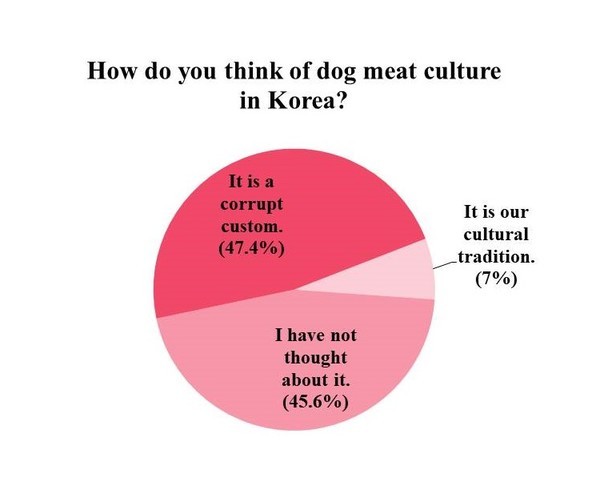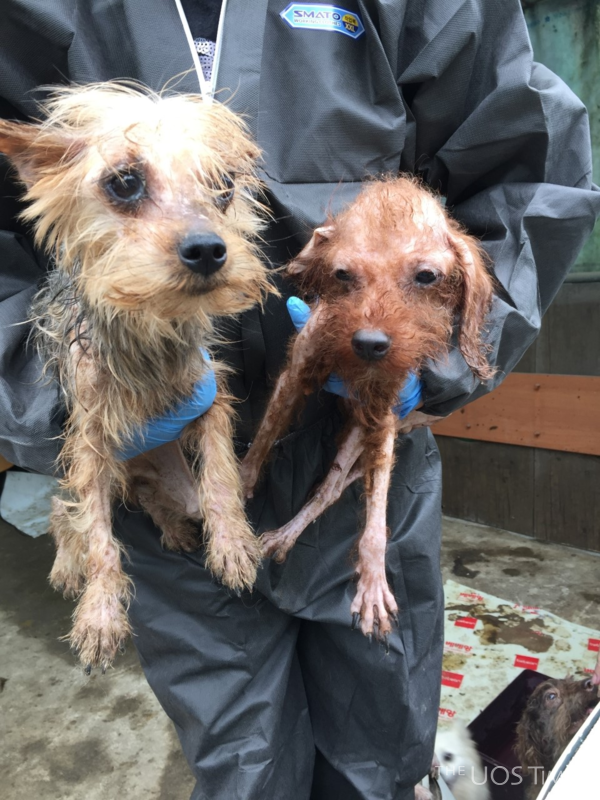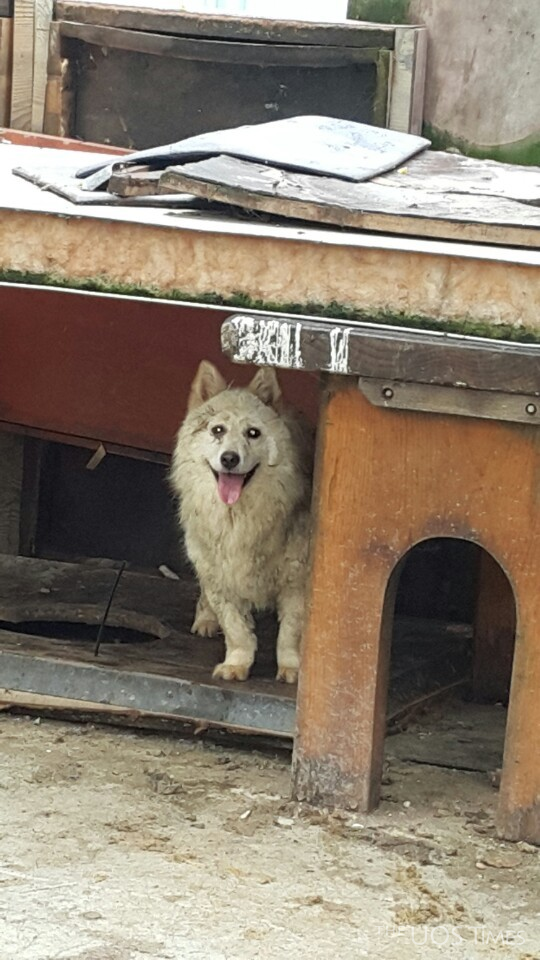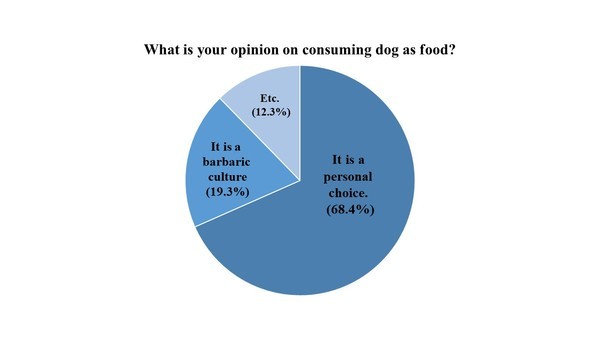There have been some negative stereotypes of Asian people, and one of them is that they are “the dog-eaters.” The practice of consuming dogs as food formed plenty of ingrained prejudices against countries that have a culture of eating dogs, and Korea is one of those. In Korea, there is a dish called Bosintang (nourishing stew, in English), which is a euphemistic reference to “dog stew.” It is the most popular on Boknal, the three hottest days according to the lunar calendar, as people tend to have nourishing food to overcome the summer’s heat.
This dog consumption culture has been continuously criticized worldwide. For instance, Brigitte Bardot, a renowned French actress, singer, and animal rights activist, rebuked the culture in public, saying that dog-eating was “not culture, but savagery.” Eating dogs has also been a controversial issue in Korea. The cruelty of slaughtering dogs and the sanitation of dog farms have always been an issue, and many animal protection groups are still trying to rescue dogs that are waiting for their death.
Even in Korea, eating dog meat with “perfectly clean hands” is near impossible. The Food Sanitation Act states that no one shall sell foods or food additives, which fail to meet the standards and specifications for commercial use. The foods allowed to be sold are listed on the Food Code published by the Ministry of Food and Drug Safety (MFDS), in which dog or dog meat cannot be found. Thus, it is illegal to serve dog meat in restaurants, according to the Food Sanitation Act.
Furthermore, although dogs are stated as livestock in the Livestock Industry Act, the Sanitary Processing of Livestock Products Act does not mention dogs as a kind of livestock for meat production; hence, there exists no code for raising and slaughtering dogs to be eaten. Therefore, the legal basis for dog consumption is unstable.


Based on the survey that The UOS Times conducted for the students of the University of Seoul (UOS), 50 out of 57 students are not planning to consume dog meat, and 47.4 percent of students think that consuming dog meat is a vice, and must be renounced. For those who are willing to consume dog meat, the reasons varied. The biggest reason is curiosity, and there were respondents who stated they had childhood experiences eating dog meat with no uncomfortable feeling, so they are willing to consume it again. However, students who were not willing to consume dog meat mentioned their biggest reason was that they simply did not think of dogs as food, and some of them said they have dogs as their companion, so consuming dogs would be heartbreaking. Some of them were even disgusted by the poor sanitation of dog farms and did not want any meat from such sanitation conditions.
Despite the vast opposition, the demand for dog meat still exists, as proved by the restaurants that have dog meat on the menu. To figure out the reasons why dogs are still slaughtered and butchered for meat, The UOS Times collected opinions from people who have different stances on this issue.
To find out the reason for the demand, The UOS Times interviewed an owner of a restaurant that has a dog meat menu. According to the owner, she is aware that using dogs as food ingredients for sale is illegal, but it is not followed, and she has no one who clamps down on hers and other dog meat restaurants. There is a clear demand, as the owner said that older people enjoy dog meat as their favorite food, in the belief of the old myth which says dog meat contains vigor, and one should have it for one's own health. Her restaurant is particularly busy on Boknal since many older people seek nourishing food on such days. Furthermore, a lot of people in poor health, such as those who receive chemotherapy for cancer, come to eat dog meat for better animal protein. She said, “The people in poor health, who have to eat anything to survive come, and not all of them are pleased to eat dogs. It seems that they are not willing to eat dogs, but they have to eat it for its supposed benefits.” Since people receiving chemotherapy need animal protein that contains less animal fat and unsaturated fat, therefore, dog meat becomes a desirable option for their needs.
Although the owner knows her customers’ demands, she saved her breath about the dog meat supplier. For the question of “Where does your dog meat come from?” she answered “Just from the butcher’s or straight from the dog farms,” nothing more. However, the owner showed a strong opinion about the regulation of dog meat. She said that the main reason why this dog meat culture became a controversial issue is that there were no certain regulations. Dogs are classified as livestock based on the Livestock Industry Act, but it is not mentioned in the Sanitary Processing of Livestock Products Act, and this contrast confuses the supplier and customers, causing debate. Her opinion about this gap is that if there are proper regulations and guidelines for raising, butchering, and eating dogs, it would be better for both dogs and people who eat dog meat.
To sum up, dogs are treated as food according to the Food Sanitation Act, treated as livestock by the Livestock Industry Act, and are not included as livestock following the Livestock Products Sanitary Control Act, which is contradictory. Because of the ambiguous legal position of dogs, the circumstances they are in are chaotic. Owners of the dog meat farms use this point in a crafty way. Some of them argue that they do not have to follow the given standard which is needed for humane treatment and sanitation because dogs are not included in the Livestock Products Sanitary Control Act.
Due to these ideas, the number of dogs being raised and slaughtered in an illegal environment keeps increasing. Illegally farmed dogs are given rotten food and water and live outdoors, captured in a cage without any protection. These dogs are exposed to extreme temperature changes, stinking smells, and pests. Cages are filled with filth, and in an even more serious situation, bodies that are decomposed can be found.

To get more detailed information about the poor surroundings of dog meat farms, The UOS Times interviewed the rescuer, who is working for an animal welfare organization. According to the rescuer, she started to rescue dogs from dog meat farms in 2018, continuing to do so from Hannam to Gupo Dog Market, and even a slaughterhouse. Related to the breed of the dogs, there is a common idea that dogs raised to be eaten are “Tosa dogs,” and dogs for meat and pet dogs are differentiated depending on their breed. However, she pointed out that this is definitely wrong. Even pedigree dogs such as Chowchow can be found on dog meat farms, and a lot of small dogs like the Yorkshire terrier, Maltese, and Pompitz are common. She described the circumstances of the farm, noting that it was terrible. The paws of the dogs were horrible because the wire mesh floated from the floor. The area under the mesh was crammed with excrements and maggots, and some dogs were even eating them. Dogs raised on that farm seemed to be starving too. To the question, “How do the owners of the dog meat farms react if you go there for the purpose of rescue?” she replied that most of them were pretending it did not matter whether they buy or sell dogs, claiming their legal ownership. With asking the reason for those farms not being regulated even though it was illegal to factory farm and distribute dogs, the rescuer answered it is because the animals are treated as objects which are legal to “own” according to the current law. Despite dogs not being classified as livestock according to the Livestock Products Sanitary Control Act, owners are free to raise their dogs on account of the prior fact. The punishment for animal cruelty is also not severe, and there are little to no cases of anyone being sentenced to imprisonment. These are the points that farms abuse.

“No life is born to be eaten. This is an obvious fact whether it is a dog, cow, or pig. If human beings are to eat them, it is necessary to regulate the breeding environment and the method of slaughter to make them more humane and sanitary.” This is what the rescuer replied with the question about Korea's dog eating culture. She thinks that hanging a dog's neck or beating them to death, which are illegal yet unofficially undertaken methods of slaughter, are too cruel. Her opinion about this problem is to improve this part immediately and to decide whether to designate dogs as edible livestock or not. Innocent lives are still dying brutally because of the indifference of the Ministry of Agriculture, Food, and Rural Affairs (MAFRA).


It still remains a question whether eating dog meat is a part of Korean culture, or a barbaric custom. According to the survey above, 68.4 percent of students in the UOS responded that it is a personal choice, and it is their food preference whether to eat dog meat, as a lot of people consume other kinds of meat. Also, 75.4 percent of students responded that dog meat consumption itself should not be outlawed. However, only 7 percent of students answered that dog eating is our own culture, and we should keep it, while 47.7 percent of them responded that we have to root out this culture. The poor surroundings of a farm and the slaughtering process being undertaken with no official guidelines are making people think that we have to eradicate such customs. To guarantee hygiene and animal welfare, organizing the laws that are conflicting in their current status, and legislating laws related to dogs are inevitable. Presently, it is a clear violation of the law to raise and distribute dogs inhumanely, and selling dog meat or the food containing it is also illegitimate. A lot of dogs are dying through this confusion among regulations. To bring an end to the agony of innocent lives, the MFDS and MAFRA must clearly decide whether to legitimize the consumption of dog meat or to completely prohibit it.

